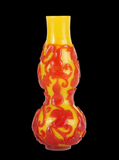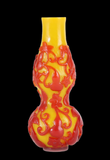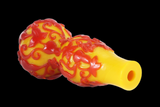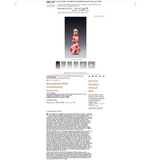Antique Chinese Peking Glass Overlay Cameo Style Snuff Bottle - Double Gourd Shape. Imperial Yellow Base With Finely Carved Prunus, Vines And Gourds. Approximately 3 5/8" High x 1 1/2" Diameter. 19th Century Or Earlier. Minor Surface Chips On The Inside Rim. Soft Polish And Patina.
For A Similar Example:
Sotheby's Hong Kong - May 26, 2014 - SNUFF BOTTLES FROM THE MARY & GEORGE BLOCH COLLECTION: PART VIII:
Lot #1086
A Ruby-Red White Overlay Glass 'Double-Gourd’ Snuff Bottle
Qing Dynasty, Qianlong Period
6.1 cm., 2 3/8 in.
PROVENANCE
T. P. Knight.
Parke-Bernet, New York, 20th December 1970, lot 2.
Margaret Prescott Wise (no. 441).
Edgar and Roberta Wise, 1995.
Robert Kleiner, London, 1996.
LITERATURE
Moss et al., 1996-2009, vol. 5, no. 911.
CATALOGUE NOTE
This example, together with such bottles as Sale 1, lot 48 and Sale 6, lot 168, represents one of the most intriguing groups of cameo-overlay glass from the eighteenth century. Their imperial status goes unquestioned, for apart from the series of wheel-cut Qianlong reign marks borne by many, they are related to a group of vessels other than snuff bottles, the majority of surviving examples of which are still in the imperial collection in Beijing. Quality varies across the group and, as so often with glass, and one can presume more than one carver/designer to have been involved. They illustrate a tendency for fairly complex designs to be poorly finished where the relief meets the ground plane, and frequently this more rudimentary style of carving extends to the relief work itself. Sale 6, lot 168 is atypically well carved and finished for the group.
By the 1760s the art of glassmaking had been well and truly mastered at court, and its novelty and the excitement it generated would have been much reduced. There would also have been additional pressure on court lapidaries owing to the massive influx of jade and other hardstones from the south-western edge of the Tarim Basin after the end of the Zunghar – Qing wars in 1759. This diversion may have drawn the emperor’s attention away from art-forms such as glass, particularly since, by the 1760’s, he would have owned an enormous number of bottles of all kinds. Under these circumstances it seems likely that standards in carved glass would have declined, lesser carvers perhaps being more often assigned to glass production while the master lapidaries concentrated on hardstones. Although the court lapidaries could still produce masterpieces—such as the extraordinary Sale 1, lot 8, from around 1780—the falling standards so evident in enamelling probably also affected glass production
This is one of the most impressive of the group, and although it lacks the characteristic reign mark, its design and colours are splendid, and the overall effect spectacular and vital. This design has been thought out specifically for this bottle and that the artistic standards of the early reign survive, despite hints of the more decorative approach of the second half of the reign.
Estimate 200,000 — 250,000 HKD
25,792 - 32,240USD
LOT SOLD. 400,000 HKD (51,584 USD)
See Image At End Of This Listing















